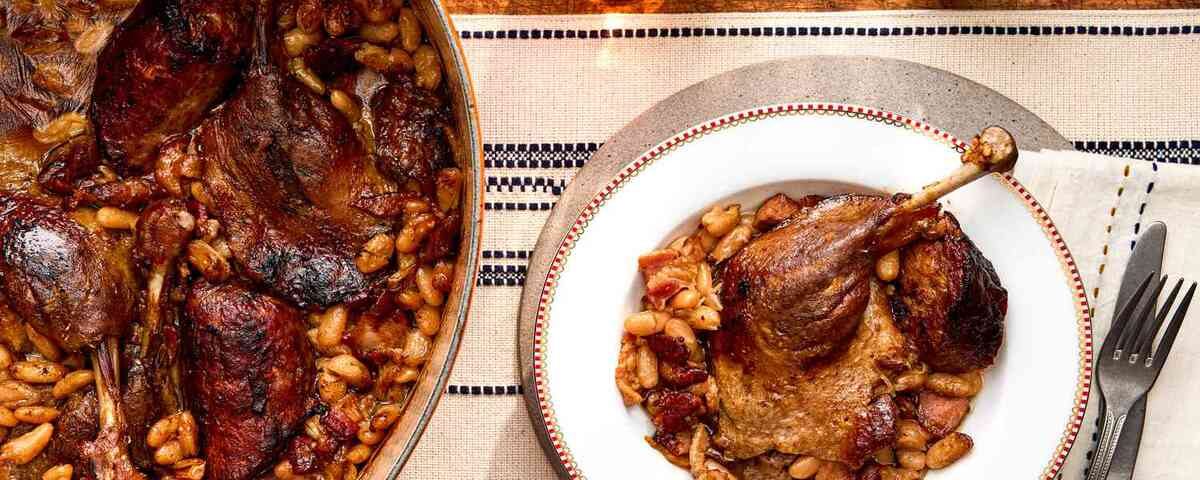
Gratin Dauphinois A Creamy Classic French Dish

Bouillabaisse A Provençal Seafood Symphony
Cassoulet: A Hearty French Classic
Introduction
Cassoulet, a rich and flavorful stew hailing from southwestern France, is a culinary masterpiece that embodies the essence of French comfort food. This hearty dish is a celebration of humble ingredients like white beans, pork, duck, and sausage, slow-cooked to perfection until they meld into a harmonious symphony of flavors. In this comprehensive guide,we will delve into the history, regional variations, ingredients, and the art of preparing this iconic French dish.
A Brief History of Cassoulet
The origins of cassoulet are shrouded in legend, with the most popular tale dating back to the Hundred Years’ War. It is said that during the siege of Castelnaudary, the townspeople, faced with dwindling food supplies, combined whatever they had – beans, pork, and other meats – into a hearty stew to sustain their spirits and bodies. The dish proved so nourishing and satisfying that it became a staple in the region.
While the legend adds a romantic touch, the reality is likely more complex. Cassoulet evolved over centuries as a peasant dish, reflecting the agricultural traditions of southwestern France. The availability of ingredients, such as white beans,pork, and duck, influenced the dish’s composition, resulting in regional variations that are still fiercely debated today.
Regional Variations of Cassoulet
Cassoulet is a dish that sparks passionate discussions among food enthusiasts, with each region claiming supremacy over its version. Here are some of the most famous cassoulet variations:
- Castelnaudary Cassoulet: This version is considered the classic, featuring a harmonious blend of white beans,duck confit, pork shoulder, and sausage.
- Toulouse Cassoulet: Often considered richer and more intense, Toulouse cassoulet includes goose confit instead of duck and a higher proportion of pork.
- Carcassonne Cassoulet: This version is known for its use of mutton or lamb in addition to pork and duck.
Essential Ingredients for Cassoulet
To create an authentic cassoulet, you’ll need the following key ingredients:
- White beans: Traditionally, Tarbais beans are used, but other varieties like Great Northern or Navy beans can be substituted.
- Pork: This includes pork shoulder, belly, and sausage.
- Duck: Duck confit is the preferred choice, but you can also use fresh duck.
- Garlic: Essential for flavoring the dish.
- Herbs: A bouquet garni of thyme, bay leaf, and rosemary adds depth of flavor.
- Breadcrumbs: Used to create a crispy top.
The Art of Making Cassoulet
Cassoulet is a labor of love that requires patience and attention to detail. Here’s a basic overview of the process:
- Prepare the beans: Soak the white beans overnight, then cook them until tender but not mushy.
- Brown the meats: Sauté the pork and duck until browned and crispy.
- Assemble the cassoulet: Layer the beans, meats, and sausage in a large earthenware pot.
- Simmer: Cover the pot and simmer in a low oven for several hours, allowing the flavors to meld.
- Create the crust: Top with breadcrumbs
- and bake until golden brown.
Serving and Enjoying Cassoulet
Cassoulet is traditionally served in individual earthenware pots, allowing each diner to experience the dish’s rich flavors and textures. It is best enjoyed with crusty bread to soak up the delicious sauce. A glass of red wine, such as a Côtes du Roussillon, complements the hearty flavors of the cassoulet.
Tips for Perfect Cassoulet
- Use high-quality ingredients: The key to a great cassoulet lies in the quality of your ingredients.
- Don’t rush the cooking process: Slow cooking allows the flavors to develop fully.
- Experiment with different beans and meats: While traditional ingredients are essential, feel free to experiment with variations.
- Save leftovers: Cassoulet is even better the next day!
Cassoulet: A Culinary Treasure
Cassoulet is more than just a dish; it is a cultural heritage that embodies the spirit of French gastronomy. Its rich history,regional variations, and complex flavors make it a truly unforgettable culinary experience. Whether you are a seasoned home cook or a curious food lover, taking the time to prepare a cassoulet is a rewarding journey that will transport you to the heart of southwestern France.


